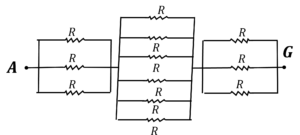For a cube of equal resistance along its edges, let’s determine the equivalent resistance between
- two vertices along the body diagonal
- two vertices along the face diagonal
- two adjacent vertices
Note that we will explore two methods here: (a) Equivalent circuit, utilizing symmetry (b) Potential method
1. Cube Resistance Problem | Equivalent resistance between two vertices along the 'body' diagonal
Approach 1 : Equivalent circuit, utilizing symmetry
Equivalent resistance between two vertices along the body diagonal is $= \cfrac{5R}{6}$. The equivalent representations are shown below which will help you understand the approach. Note that vertices $B$, $D$, and $E$ are at the same potential because of symmetry and similarly $C$, $F$ and $H$ are at the same potential.



Approach 2 : Current Method
Assume that the current flowing into vertex $A$ is $i$. Now because of the symmetry we can assign the current in different branches as follows
Now, to establish Potential difference, $V_{AG}$, between vertices $A$ and $G$ let’s follow the path $A – B – C – G$ and let’s write down the potential drop
So, $V_{AG} = \cfrac{i}{3} R + \cfrac{i}{6} R + \cfrac{i}{3} R$ $= \cfrac{5R}{6} i$
So $R_{eq} = \cfrac{V_{AG}}{i} = \cfrac{5R}{6}$

2. Cube Resistance Problem | Equivalent resistance between two vertices along the 'face' diagonal
Approach 1 : Equivalent circuit
Equivalent resistance between two vertices along the face diagonal is $= \cfrac{3R}{4}$. The equivalent representations are shown below which will help you understand the approach.
Note that circuit is symmetric about $B-F-H-D$ as inidicated by red dotted line, meaning all these vertices are at the same potential which helps us simplify the circuit as shown below



Approach 2 : Potential Method

Having assigned potentials to different vertices (taking into account the symmetry), we will now write the junction rule for vertices $D$, $E$ and $F$, which will give us 3 equations in 3 unknowns, namely, $V_1$, $V_2$ and $V_3$
So, writing the junction rule at $E$ will give us
$\cfrac{V-V_2}{R} = \cfrac{V_2-V_3}{R} + \cfrac{V_2-V_3}{R}$
At junction $H$, we will have
$\cfrac{V_2-V_3}{R} = \cfrac{V_3-V_1}{R} + \cfrac{V_3-(V-V_2)}{R}$
At junction $D$, we will have
$\cfrac{V-V_1}{R} = \cfrac{V_1-V_3}{R} + \cfrac{V_1}{R}$
And writing the equivalent resistance equation for junction $A$ we get
$\cfrac{V}{R_{eq}} = \cfrac{V – V_2}{R} + \cfrac{V-V_1}{R} + \cfrac{V-V_1}{R}$ $\cdots$ (1)
Solving for $V_1$ and $V_2$ in terms of $V$ and substituting them in equation $1$ we get,
$R_{eq} = \cfrac{3R}{4}$
3. Cube Resistance Problem | Equivalent circuit between two adjacent vertices
Approach 1 : Equivalent circuit
Equivalent resistance between two adjacent vertices $= \cfrac{7R}{12}$. The equivalent representations are shown below which will help you understand the approach.
Note that branch 2 and 3 have horizontal symmetry (as indicated by dotted red line) which helps us simplify the circuit as shown below







